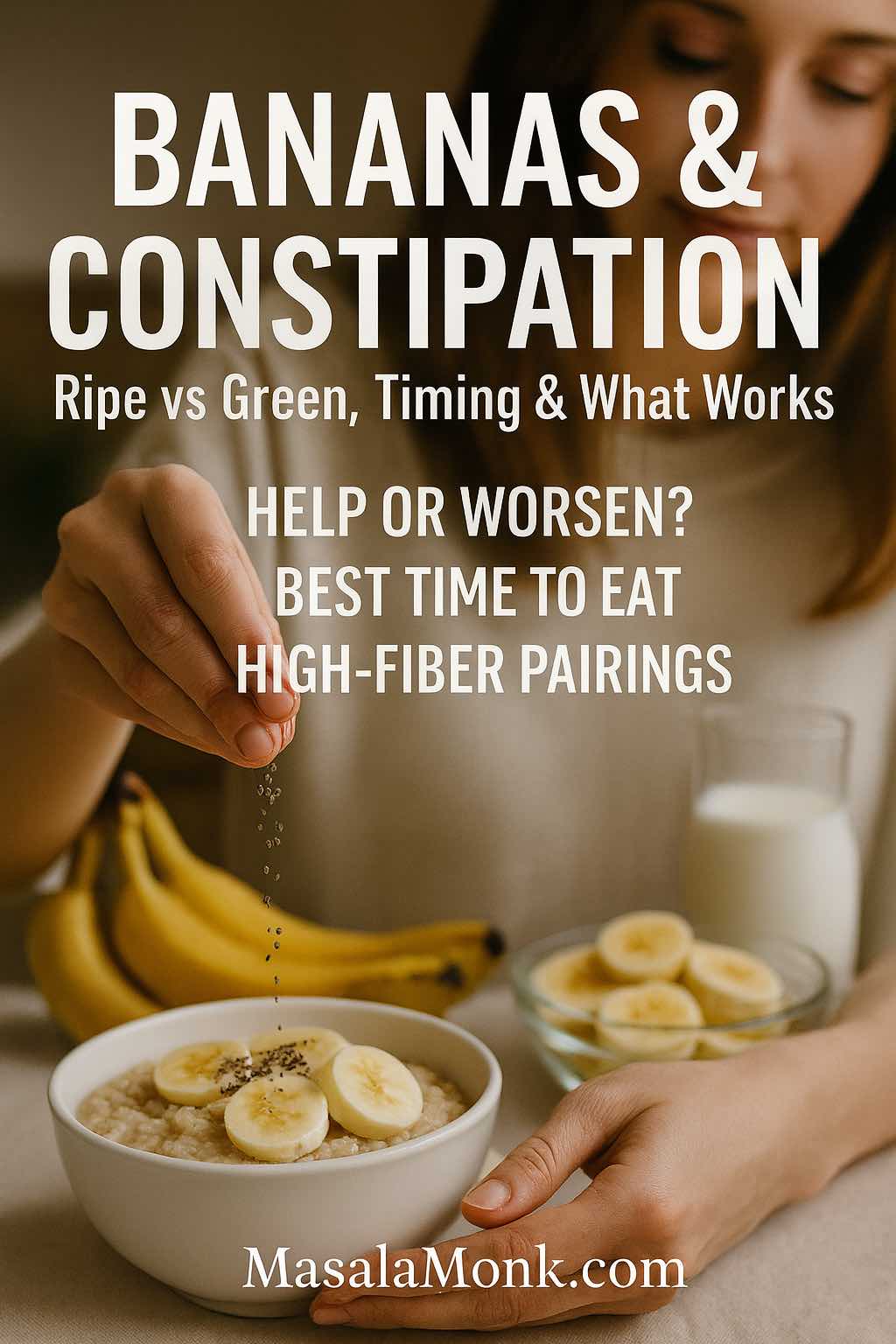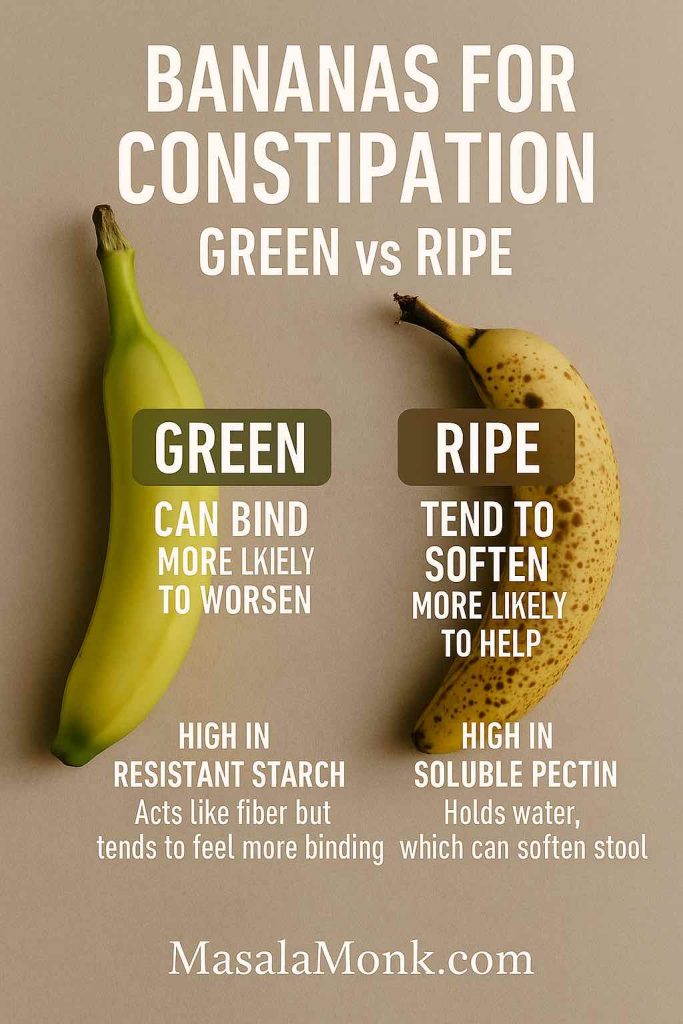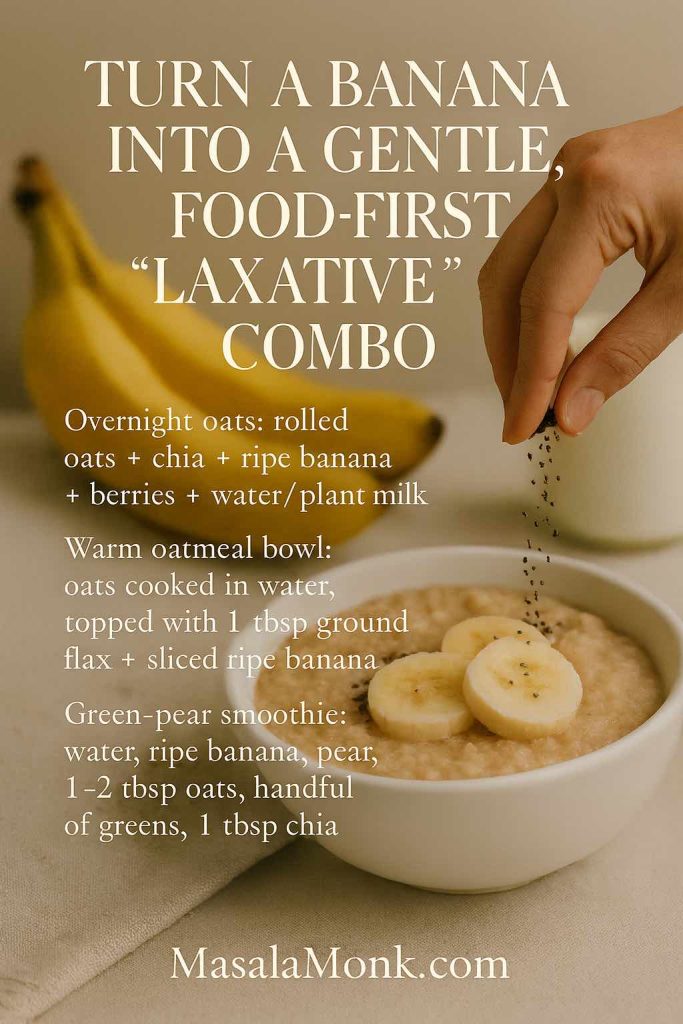
If you’ve ever wondered whether bananas relieve constipation or make it worse, you’re not alone. Some people swear a banana helps them go; others feel more backed up. The contradiction is real, yet the explanation is straightforward—and practical. As bananas ripen, their carbohydrate profile shifts in a way that can either soften stool or, conversely, bind it. Once you understand that shift—and then pair bananas with a few smart foods at the right time of day—you can use them more confidently for constipation relief.
Let’s walk through what actually changes as bananas ripen, how that affects bowel movements, and exactly how to build gentle, food-first routines that work in the real world.
Also Read: Bananas and Acid Reflux: Do They Help or Cause Heartburn?
Why ripeness matters in Bananas for Constipation?
Here’s the kitchen science you can actually use. When bananas are green or very firm, they’re higher in resistant starch—a form of starch that behaves like fiber because it resists digestion in the small intestine. As bananas ripen to yellow with brown speckles, that resistant starch declines while soluble pectin rises. Soluble, gel-forming fibers like pectin help stool hold water, which can soften it and support smoother bowel movements. In other words: greener bananas are more likely to feel binding, whereas ripe bananas tend to be gentler when you’re backed up.

This isn’t speculation; it’s been measured directly across ripening stages in compositional analyses of bananas (see a helpful overview in PLOS ONE: “Bananas at Different Stages of Ripeness: Dietary Fiber, Starch and Sugars”). As a result, there’s a simple rule of thumb you can rely on: if you’re aiming to ease constipation, choose bananas that are yellow with light brown speckles, not green or rock-firm.
Also Read: How Much Potassium Is in a Banana? Nutrition Facts, Comparisons & Benefits.
Why green bananas show up in diarrhea diets (and what that means for you)
MasalaMonk.comTo make the picture even clearer, consider the other end of the spectrum. Because green bananas are relatively rich in resistant starch, they often appear in diets for persistent diarrhea. In controlled settings, introducing green banana or purified pectin reduced stool output and shortened symptoms (for example, in studies summarized here: Gastroenterology and PubMed). That “binding” quality is useful for loose stools—but it’s not what you’re looking for when you’re constipated. Consequently, when you feel backed up, avoid very green bananas and reach for ripe ones instead.
Also Read: Electrolytes and Diarrhea: Best Drinks to Restore Balance Naturally
The practical take away—what to choose, and how to use it
So, what’s the simplest plan? First, pick a ripe banana, ideally one that’s yellow with a few brown speckles. Next, rather than eating it on its own and hoping for the best, stack the odds in your favor with two small tweaks:
- Pair your banana with gel-forming, soluble-rich foods—think oats, barley, chia, ground flax, psyllium, and tender legumes.
- Time it with or right after meals and follow with water and a 10–15-minute walk.
Why the timing? Because your gut naturally ramps up motility through the gastrocolic reflex—the “eat → colon moves” signal—especially in the morning and after larger meals. Pairing a ripe banana with food and a short walk leverages a reflex your body already intends to use (helpful explainers here: StatPearls and the Cleveland Clinic).
Also Read: Hemorrhoids High Fiber Diet: Best Foods, What to Avoid, and a 7-Day Plan
How much banana actually helps?
Gentle and consistent beats heroic. Start with ½–1 ripe banana per day while constipated. If you notice you’re not moving, don’t just stack on more bananas. Instead, dial up variety—for example, add kiwifruit or prunes—and add water. Gel-forming fibers do their best work when you actually give them water to hold. If bloating appears, reduce portion sizes temporarily and spread fiber-rich foods across the day.
Turn a banana into a gentle, food-first “laxative” combo
Because bananas shine when paired with gel-forming fibers, the following ideas often help sooner and more comfortably than bananas alone:
- Overnight oats: rolled oats + chia + ripe banana + berries + water/plant milk.
- Warm oatmeal bowl: oats cooked in water, topped with 1 tablespoon ground flax and sliced ripe banana.
- Green-pear smoothie: water, ripe banana, pear, 1–2 tablespoons oats, handful of greens, 1 tablespoon chia.
- Yogurt bowl (dairy or plant-based): unsweetened yogurt + ripe banana + kiwi + 2 teaspoons psyllium; follow with a full glass of water.
- Lentil-barley soup + fruit: cozy bowl for lunch; pair with a ripe banana or two kiwis later.
Why these work bears repeating. A large review of fiber interventions in chronic constipation finds fiber helps, and specifically that psyllium, doses above ~10 g/day, and at least four weeks of consistent use yield the most reliable improvements in stool frequency and consistency (meta-analysis overview). You don’t necessarily need a supplement to benefit, but the gel-forming fibers present in oats (beta-glucans), banana (pectin), and chia/flax (mucilage) act in a similar, water-holding way. If you do choose a psyllium supplement, mix thoroughly with water and increase gradually—more on timing and precautions in this practical guide: When to Take Metamucil.
Two fruits deserve a special mention because they’ve shown benefits in randomized adult trials:
- Kiwifruit: Two gold kiwifruit daily performed as well as fiber-matched psyllium for constipation relief in a randomized trial, with low rates of side effects (open-access RCT).
- Prunes: In a head-to-head trial, prunes outperformed psyllium for stool frequency and consistency in mild to moderate constipation; other controlled work shows prune juice can normalize stool without causing excessive looseness (for example, AJG trial and a focused analysis in Clinical Nutrition).
Also Read: Psyllium Husk (Isabgol/Ispaghula) Side Effects: Risks, Benefits & How to Take It Safely

Timing it right (because when you eat matters, too)
Let’s tie timing to physiology. The gastrocolic reflex—the built-in “make room” signal—spikes after you eat, particularly after breakfast and lunch for many people. Consequently, if you’re aiming for a reliable bowel movement:
- With or right after breakfast: banana + oats + chia; water; short walk.
- With lunch: banana + lentil soup; water; walk.
- Before bed? It’s fine if you like, but most people get better results by riding that post-meal wave rather than snacking far from mealtime.
Even better, build a repeatable rhythm. Your gut loves routine as much as your calendar does.
What to do if bananas feel binding
Even with the best intentions, a banana can feel heavy if it’s too green, if fluid intake is low, or if you’re stacking several in a short window. If things slow down:
- Switch to a more ripe banana (yellow with speckles).
- Cut the portion to half and pair with oats/chia/flax.
- Increase fluids and add a 10–15-minute walk after meals.
- Rotate to other soluble-forward fruits—pears, oranges, berries—or try two kiwis or a small portion of prunes for two to four weeks.
In case you are looking for a deeper read on why fiber works and how to layer foods without discomfort, these friendly guides are worth bookmarking: Significance of Fiber in Diet and Flax Seeds: The Tiny Powerhouse for Strong Digestion. If you’re considering a supplement, also skim this plain-language overview of Metamucil timing, mixing, and side effects.
Build your plate around bananas for constipation
To keep momentum going through the day, think soluble-forward first, then add variety:
- Fruits: kiwi, prunes/prune juice, pears, apples (with skin), oranges, berries. (Kiwi and prunes have randomized support; pears and apples bring pectin; citrus adds more soluble fiber.)
- Vegetables: carrots and okra lean soluble; Brussels sprouts, broccoli, and leafy greens round out fiber diversity.
- Grains & seeds: oats and barley for beta-glucans; chia and ground flax for mucilage and omega-3s.
- Legumes: lentils, chickpeas, beans, and split peas—cook until tender; start with small portions if you’re sensitive.
Moreover, if you’re thinking about your microbiome more broadly, layering prebiotic and probiotic strategies can help. A friendly, practical overview to get you oriented is here: Probiotics and Prebiotics for Constipation Relief.

Three minimalist daily frames you can start tomorrow
Because consistency beats perfection, here are three easy routines that keep fiber, fluids, and timing working together:
1) Morning momentum
- Breakfast: oats cooked in water + ripe banana + chia; coffee or tea if you like.
- After breakfast: a 10–15-minute walk.
- Mid-morning: water bottle check; a pear if you’re hungry.
2) Lunch lift
- Lunch: lentil-barley or split-pea soup; side salad with olive oil.
- Snack: two gold kiwis or a small handful of prunes.
- Walk: 10 minutes between meetings.
3) Evening ease
- Dinner: bean-and-vegetable stew over brown rice or barley.
- Dessert/snack: yogurt (dairy or plant-based) + ripe banana + ground flax.
- Wind-down: a warm drink; brief stretching.
If, after a couple of weeks, you still feel stuck despite these routines, consider a short course of psyllium while keeping the food pattern in place. Many adults do well starting with a small dose daily, mixed with at least 240 ml of water, and slowly increasing. For a practical, label-wise walkthrough, see: When to Take Metamucil.
When bananas aren’t enough for constipation
Despite best efforts, sometimes you’ll need more than bananas and oats. Before you reach for stimulant laxatives, it’s reasonable to trial kiwifruit or prunes for two to four weeks, because each has controlled adult data with good tolerability (gold-kiwi RCT and prunes vs psyllium trial). If gas or bloating crop up, reduce portion sizes temporarily and spread fiber through the day. And of course, if constipation persists beyond a couple of weeks—or if you notice blood in the stool, severe pain, fever, or unintended weight loss—please speak to a clinician. Long-standing constipation deserves a full look at diet, hydration, medications, and pelvic-floor mechanics, not just more fiber.
Also Read: Kiwi Fruit: Nutrition, Benefits, and How to Eat It 🥝🌱
Bringing it all together – Bananas for constipation
To recap, bananas aren’t inherently constipating or laxative; it’s the ripeness that nudges their effect in one direction or the other. Ripe, speckled bananas lean soluble, which can soften stool. Green bananas skew resistant starch, which can bind—helpful for diarrhea, but not ideal when you’re stuck. Consequently, rather than debating bananas in the abstract, align your choice with your current goal, pair it with other gel-forming fibers, drink water, and time it after meals to ride the gastrocolic reflex. If you need an extra nudge, kiwi or prunes are well-studied, food-first options; and when you want to deepen your toolkit, you’ll find practical add-ons at MasalaMonk such as a friendly fiber primer, a look at flax seeds for digestion, and a guide to prebiotics and probiotics.
FAQs on Bananas for Constipation
1) Do bananas for constipation actually help?
Yes—ripe bananas can help many adults. As they ripen, their soluble pectin increases, which holds water and can soften stool. However, results vary; therefore, pair ripe bananas with fluids and other soluble-fiber foods for steadier relief.
2) Are bananas good for constipation or diarrhea?
Both—but it depends on ripeness. Ripe, lightly speckled bananas tend to support constipation relief, whereas greener bananas, richer in resistant starch, may feel binding and are often better when stools are too loose.
3) Are bananas constipating or laxative?
Neither, strictly speaking. Instead, ripeness nudges the effect: greener can bind, riper can soften. Consequently, if you’re backed up, reach for ripe bananas, not green ones.
4) What is the best time to eat a banana for constipation?
Generally, with or right after meals—especially breakfast or lunch. After eating, the gut’s natural “gastrocolic reflex” kicks in, so timing a ripe banana then, followed by water and a short walk, often works best.
5) How many bananas should I eat when constipated?
Start modestly with ½–1 ripe banana per day. Moreover, increase slowly as tolerated. Meanwhile, keep water intake up and round out your day with other soluble-rich options like oats, chia, ground flax, or psyllium.
6) Can bananas cause constipation in adults?
They can—if they’re very green, if you’re short on fluids, or if you eat several at once. In that case, switch to riper fruit, cut the portion, and add more water and gel-forming fiber from other foods.
7) Do bananas help you poop fast?
Sometimes. A ripe banana plus soluble-fiber companions (for example, oats + chia) and a brief post-meal walk can nudge a bowel movement. Nevertheless, consistency over days wins more reliably than a single “quick fix.”
8) Are ripe bananas good for constipation relief specifically?
Yes. Ripe, lightly speckled bananas provide more soluble pectin, which may soften stool and ease passage. Furthermore, they combine well with high-fiber meals to support regularity.
9) Should you eat bananas if you are constipated?
Yes—choose ripe bananas and include them as part of a high-fiber meal pattern. In short, think “bananas for constipation” and “soluble-fiber friends,” not bananas alone.
10) Do bananas make constipation worse for some people?
Occasionally. On the other hand, this usually happens with green bananas, low fluid intake, or large servings. Therefore, shift to riper fruit, reduce the portion, and diversify your fiber sources.
11) Are bananas a good choice for bowel movements in adults?
Often, yes. Additionally, adults tend to benefit from routine: ripe banana with breakfast, a glass of water, and a 10–15-minute walk—plus a fiber-forward lunch—can create dependable momentum.
12) Which fruits are high fiber for constipation besides bananas?
Consider kiwi, prunes, pears, apples (with skin), oranges, and berries. Notably, kiwi and prunes are especially helpful for stool frequency and consistency, while pears and apples are rich in pectin.
13) What vegetables and grains pair well with bananas for constipation relief?
Prioritize oats and barley (beta-glucans), then add carrots, okra, and Brussels sprouts for soluble-leaning fiber. Moreover, rounding out the day with lentils, chickpeas, or beans enhances total fiber and supports bowel movement quality.
14) How do plant-based, high-fiber diets fit with bananas for constipation?
Seamlessly. A plant-based high-fiber diet—rich in legumes, whole grains, fruits, vegetables, nuts, and seeds—makes it easier to hit daily fiber targets. Meanwhile, a ripe banana becomes an easy, portable add-on that harmonizes with the rest.
15) What’s the difference between soluble and insoluble fiber for constipation?
Soluble fiber (e.g., pectin, beta-glucans, psyllium) forms a gel that softens stool. Insoluble fiber (e.g., wheat bran, veggie skins) adds bulk. For constipation relief, begin with soluble-leaning foods, then layer in gentle insoluble fiber as tolerated.
16) Can eating too many bananas make me constipated?
Potentially—especially if they’re not fully ripe or if water intake is low. Consequently, cap it at ½–1 ripe banana daily while you troubleshoot, and diversify with other high-fiber foods for adults.
17) Are bananas good or bad for gut health overall?
Generally good—particularly when ripe and eaten with a variety of high-fiber foods for gut health. Still, tolerance varies; therefore, adjust ripeness and portion to how your body responds.
18) Do bananas help with bowel movements if I’m following a low-FODMAP approach?
Possibly, with nuance. Just-ripe bananas may be better tolerated than very ripe ones. Even so, keep portions moderate, space fiber through the day, and focus on overall comfort rather than perfection.
19) What else should I do—besides bananas—for constipation relief?
In addition to ripe bananas, emphasize soluble-rich meals, steady hydration, and short walks after meals. If needed, try small, gradual amounts of a gel-forming fiber like psyllium, alongside high-fiber fruits and vegetables for constipation.
20) When should I see a clinician instead of relying on bananas and fiber?
Seek care promptly if constipation lasts more than a couple of weeks, or if you notice red flags such as blood in stool, severe pain, fever, or unintended weight loss. Ultimately, persistent symptoms deserve a full, personalized evaluation.
Helpful research to keep on hand:
- Ripening chemistry in bananas: PLOS ONE—Bananas at Different Stages of Ripeness
- Green banana/pectin in persistent diarrhea (binding effect): Gastroenterology and PubMed
- Gastrocolic reflex explainer: StatPearls and Cleveland Clinic
- Fiber meta-analysis (psyllium, dose, duration): PubMed abstract
- Kiwifruit RCTs: Open-access trial—gold kiwi vs psyllium
- Prunes vs psyllium (head-to-head): American Journal of Gastroenterology and Clinical Nutrition study










[…] Also Read: Bananas for Constipation: Ripe vs Green, Timing & What Works […]
[…] Also Read: Bananas for Constipation: Ripe vs Green, Timing & What Works […]
[…] they help and sometimes they don’t, ripeness is the missing variable. Our blog post and guide to bananas for constipation: ripe vs green explains when each makes sense and how to use […]